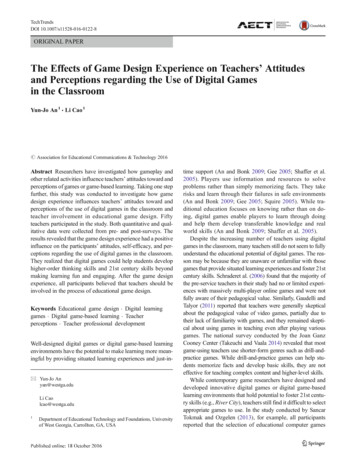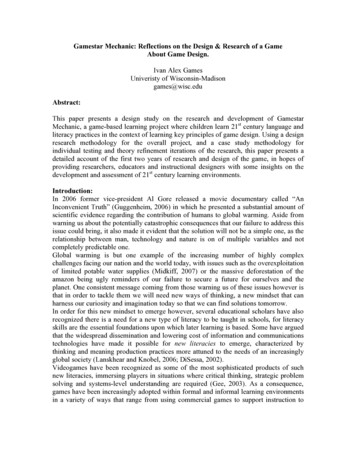
Transcription
TechTrendsDOI 10.1007/s11528-016-0122-8ORIGINAL PAPERThe Effects of Game Design Experience on Teachers’ Attitudesand Perceptions regarding the Use of Digital Gamesin the ClassroomYun-Jo An 1 & Li Cao 1# Association for Educational Communications & Technology 2016Abstract Researchers have investigated how gameplay andother related activities influence teachers’ attitudes toward andperceptions of games or game-based learning. Taking one stepfurther, this study was conducted to investigate how gamedesign experience influences teachers’ attitudes toward andperceptions of the use of digital games in the classroom andteacher involvement in educational game design. Fiftyteachers participated in the study. Both quantitative and qualitative data were collected from pre- and post-surveys. Theresults revealed that the game design experience had a positiveinfluence on the participants’ attitudes, self-efficacy, and perceptions regarding the use of digital games in the classroom.They realized that digital games could help students develophigher-order thinking skills and 21st century skills beyondmaking learning fun and engaging. After the game designexperience, all participants believed that teachers should beinvolved in the process of educational game design.Keywords Educational game design . Digital learninggames . Digital game-based learning . Teacherperceptions . Teacher professional developmentWell-designed digital games or digital game-based learningenvironments have the potential to make learning more meaningful by providing situated learning experiences and just-in* Yun-Jo Anyan@westga.eduLi Caolcao@westga.edu1Department of Educational Technology and Foundations, Universityof West Georgia, Carrollton, GA, USAtime support (An and Bonk 2009; Gee 2005; Shaffer et al.2005). Players use information and resources to solveproblems rather than simply memorizing facts. They takerisks and learn through their failures in safe environments(An and Bonk 2009; Gee 2005; Squire 2005). While traditional education focuses on knowing rather than on doing, digital games enable players to learn through doingand help them develop transferable knowledge and realworld skills (An and Bonk 2009; Shaffer et al. 2005).Despite the increasing number of teachers using digitalgames in the classroom, many teachers still do not seem to fullyunderstand the educational potential of digital games. The reason may be because they are unaware or unfamiliar with thosegames that provide situated learning experiences and foster 21stcentury skills. Schraderet al. (2006) found that the majority ofthe pre-service teachers in their study had no or limited experiences with massively multi-player online games and were notfully aware of their pedagogical value. Similarly, Gaudelli andTalyor (2011) reported that teachers were generally skepticalabout the pedagogical value of video games, partially due totheir lack of familiarity with games, and they remained skeptical about using games in teaching even after playing variousgames. The national survey conducted by the Joan GanzCooney Center (Takeuchi and Vaala 2014) revealed that mostgame-using teachers use shorter-form genres such as drill-andpractice games. While drill-and-practice games can help students memorize facts and develop basic skills, they are noteffective for teaching complex content and higher-level skills.While contemporary game researchers have designed anddeveloped innovative digital games or digital game-basedlearning environments that hold potential to foster 21st century skills (e.g., River City), teachers still find it difficult to selectappropriate games to use. In the study conducted by SancarTokmak and Ozgelen (2013), for example, all participantsreported that the selection of educational computer games
TechTrendswas a very difficult process since most of the computer gameswere not suitable for young children and not aligned with theEarly Childhood Education (ECE) curriculum. One way toaddress this challenge is to involve teachers in the game design process. Collaboration among teachers, researchers, instructional designers, and game developers would lead to thecreation of effective digital learning games that can be used byteachers in schools. It is important to understand teachers’perspectives in order to create such games. However, littleresearch has investigated teachers’ game design experiencesand their perceptions of teacher involvement in educationalgame design. This study addressed this gap by investigatingthe effects of game design experience on teachers’ attitudestoward and perceptions of the use of digital games in theclassroom.Teachers’ Attitudes toward and Perceptionsof GamesLiterature suggests that many teachers are unaware or skeptical of the pedagogical value of digital games partially due to alack of experience with games (Gaudelli and Talyor 2011;Schrader et al. 2006). Several researchers have investigatedhow gameplay and other related activities influence preservice teachers’ attitudes toward and perceptions of gamesor game-based learning. For example, Ray and Coulter (2010)examined how playing digital mini-games change pre-serviceteachers’ perceptions of the value of digital mini-games. Theyfound that the majority of the participants had a positivechange in their perceptions after having played selectedmini-games. They believed that digital mini-games could support meaningful learning. Kenny and McDaniel (2011) alsofound that pre-service teachers developed more positive attitudes toward games after playing the Tiger Woods PGA Tour07 golf game. These findings indicate that positive gameplayexperience could help pre-service teachers see the educationalvalue of games.Similarly, Kennedy-Clark et al. (2011) examined the effects of a two-hour workshop on the integration of gamebased learning into inquiry learning on pre-service teachers’attitudes towards game-based learning. The results of thestudy showed that there was a significant change in the participants’ attitudes towards game-based learning as a result ofthe two-hour workshop. The pre-service teachers in the studyconducted by Sardone and Devlin-Scherer (2010) not onlyexplored digital learning games but also taught their selectedgame to middle or high school students. After the field experience, they were asked to make a 20-minute presentation tothe class. The results indicated that the field experience andpeer presentations had a positive influence on their attitudes.The pre-service teachers felt positive and confident about integrating digital games into teaching.While studies on pre-service teachers report consistentlypositive results, studies involving in-service teachers revealteachers’ practical concerns about the use of games in theclassroom, as well as the positive changes of their attitudesand perceptions. For example, Becker (2007) had in-serviceteachers play, examine, and discuss a wide variety of games ina graduate-level course on digital game-based learning. Theresults showed that while all participants were enthusiasticabout the potential of digital games to enhance learning as aresult of analyses and discussions of various games, they continued to feel that integrating games in the curriculum was stilla long way off.Gerber and Price (2013) examined in-service teachers’ perceptions focusing on the use of commercial off-the-shelf(COTS) video games in English Language Arts classrooms.Ten literacy teachers in their study explored several multi-uservirtual environments and played a COTS game whileresearching literacy activities directly related to the game theyhad selected to play. The study found that while the participants saw the value of game-based learning pedagogy andwould like to use game-based learning, they were concernedthat their schools and colleagues would not be open to gamebased pedagogy.In a similar vein, Gaudelli and Talyor (2011) investigatedsocial studies teachers’ perspectives of the use of serious videogames in the context of global education. Seven teachers participated in a series of activities, including a focus group meeting, gameplay, blogging, and focus-group reflection. The results from the initial focus group meeting showed that theparticipants were generally skeptical about the pedagogicalvalue of video games, due in part to their lack of familiaritywith this type of media. Even during and after the gameplayand other activities, the participants remained skeptical aboutteaching global content through video games. Their findingsshould be carefully interpreted since teachers might have different views with different social studies topics.In sum, the above studies examined the changes inteachers’ attitudes and perceptions after being exposed to orplaying games. Examining the changes in teachers’ attitudesand perceptions after game design taps into a relatively unexplored area.Teachers’ Game Design ExperienceAlmost two decades ago, Kafai et al. (1998) examined howstudents and pre-service teachers conceptualize the task ofcreating games for others. Study 1 focused on fifth gradestudents designing games to teach fractions to younger children, and Study II focused on teams of pre-service teachersengaged in the same task. The participants created games onpaper but did not implement them on the computer. The results of their study showed that both students and teachers
TechTrendsshifted from extrinsic game design, where fraction content andgame idea were unrelated (e.g., shooting rockets and solvingfraction problems when missing rockets), to intrinsic gamedesigns, where game idea and fraction content were integrated(e.g., assembling fractions of a map to progress through thegame). Despite these interesting findings and its undoubtedimportance, teachers’ experience of game design has not beenactively explored until more recently.Li et al. (2013) examined pre-service teachers’ digitalgame design experience in a secondary mathematicsmethods course at a Canadian university. Twenty-onepre-service teachers in the study were first introduced tovarious online games, and then they were engaged ingame design and development. Scratch was introducedin a face-to-face class, but they had the freedom to useany game design software. The results showed that manyparticipants experienced difficulty in translating their design ideas to a game. Some participants had to completelychange their game designs to fit the program they used.After developing their own games, about 40 % of theparticipants mentioned problem solving as a benefit oflearning through game design, while only two teachersmentioned problem solving in the pre-survey. The interview results indicated that the game design process enabled the participants to use all the 21st century skills.Instead of asking pre-service teachers to design theirown games, Sancar Tokmak and Ozgelen (2013) hadpre-service teachers redesign existing computer games.In the first condition, early childhood education preservice teachers who participated in the study were askedto select a computer game and prepare a game-based lesson plan. In the second condition, the participants wereasked to redesign the selected computer game and preparea game-based lesson plan. The comparisons of selectedand redesigned computer games revealed that most participants made considerable changes to the computer gamesselected. Interestingly, 62 % of the participants applied aconstructivist learning theory when they redesigned computer games, while the majority of the participantsplanned to apply a behaviorist philosophy in the first condition. The participants reported that they could not integrate the selected computer games into teaching based ona constructivist philosophy, because they required children to have pre-knowledge to play. The interview resultsindicated that the characteristics of computer games andthe opportunities to see classmates’ lesson plans were themajor factors affecting their game integration decisions.While previous studies focused on pre-service teachers’game design experiences, Li (2012) explored theaffordances and constraints of in-service teachers’ experiences in designing and developing digital games for instructional purposes. Fourteen teachers enrolled in a 14week graduate course at a Ca nadian universityparticipated in the study. The participants were exposedto current literature related to digital game-based learningas well as existing games for the first 9 weeks, and thenthey focused on the design and development of their owninstructional games starting in Week 10. Scratch was chosen as the primary development software, but thoseteachers with programming skills chose to use more advanced software such as Adobe Flash. The results of thestudy showed that the game design and development process improved the participants understanding about gamebased learning and afforded them opportunities to reconceptualize pedagogy. Specifically, they adopted a moreholistic approach by integrating different subjects, skills,and knowledge. Some teachers involved their students inthe design process and co-designed digital games. Thedesign experience transformed classroom teaching frompassive content consumption to active knowledge generation. Regarding constraints, the researcher identified fourmajor challenges faced by teachers during their gamebuilding process, including technical challenges, limitedtime and resources, pedagogical challenges, and the conflict between educational context and game genre.Although previous research provides insight into the benefits and challenges teachers experience in the process ofgame design, no study to date has provided empirical evidenceof the impact of game design experience on teachers’ attitudestoward and perceptions of digital games and teacher involvement in educational game design. This study, therefore, aimedto address the following research questions:1. What impact does the game design experience have onteachers’ attitudes, self-efficacy, and perceptions regarding the use of digital games in the classroom?2. To what extent does the game design experience influenceteachers’ perceptions of teacher involvement in educational game design?MethodsParticipantsParticipants in this study were 50 teachers enrolled in twosections of an online graduate course in the College ofEducation at a public university in the southeastern UnitedStates. They ranged in age from 22 to 54 years old. Of theparticipants, over 50 % were in their 20s, 76 % (n 38) werefemale, and 58 % (n 29) self-identified as Caucasian.Participants’ teaching experience varied from less than 1 yearto 20 years, with 80 % of participants (n 40) reporting 0–5 years of teaching experience. Table 1 summarizes the demographic information of the participants.
TechTrendsTable 1Summary of participant demographic information (n 50)Characteristicn%Characteristicn%20–29 years2652 %Female3876 %30–39 years40–49 years111122 %22 %Male1224 %50–59 yearsEthnicity24%Caucasian2958 %0–5 years4080 %African-AmericanMultiracial17334 %6%6–10 years11–15 years438%6%Hispanic American12%16–20 years36%AgeGenderTeaching Experiencedemographic questions, five open-ended items, and 25Likert-scale items. The post-survey included the sameLikert-scale items and seven open-ended items. The pairedsamples t-tests were used to compare pre- and post-surveyscores in the following three categories: (1) attitudes andself-efficacy, (2) educational benefits of digital games, and(3) concerns. Further, the Wilcoxon Matched Pairs SignedRank test, a nonparametric test for comparing two pairedgroups, was used to compare pre- and post-scores for individual items. All qualitative data were carefully examined, coded,and constantly compared for thematic analysis. For the educational benefits category, qualitative data from the pre-surveyand those from the post-survey were compared to examine theparticipants’ perception changes.ProcedureResultsThis study focused on a game design assignment, in whichstudents were asked to design a digital learning game for theirstudents. The game design assignment consisted of five parts:(1) pre-survey, (2) reading, (3) game design, (4) peer feedback, and (5) post-survey. Students who chose to participatein this study were asked to read and sign the informed consentform and submit their signed consent form electronically.After receiving the signed consent forms, the instructor, thesecond author of this study, sent a link to the pre-survey to theparticipants via email. After they completed the pre-survey,the instructor provided them with articles related to well designed games and game-based learning environments and detailed instructions for the game design assignment, including agame design document template. The participants were encouraged to read the given articles before designing theirown game. The participants were given 4 weeks for readingand game design. They did not use game design software forthe game design assignment. Findings from previous researchon teachers’ game design showed that teachers’ limited programming skills or the constraints of game design softwareoften prevented them from implementing their original ideas(Li 2012; Li et al. 2013). Therefore, this study engaged theparticipants in conceptual design. They were asked to designtheir own educational game by completing a game designdocument. After submitting their game design documents,the participants were asked to review others’ game designdocuments and provide feedback to at least three classmateson their game designs. After the peer feedback activity, theinstructor sent a link to the post-survey to the participants viaemail.AttitudesParticipants’ attitudes toward the use of digital games in theclassroom were measured using four Likert-scale items.Overall, the post-survey scores (M 3.54, SD .44) weresignificantly higher than the pre-survey scores (M 3.34,SD .62) (t(49) 2.333, p .024) in the attitudes category.A Wilcoxon Matched Pairs Signed Rank test also revealed astatistically significant difference between pre-survey andpost-survey scores for all four items (See Table 2). This finding suggests that the game design experience had a positiveinfluence on the participants’ attitudes toward the use of digital games in teaching.Qualitative data supported the finding. A number of participants commented that the game design assignment helpedthem see the educational potential of digital games and madethem become more interested in the use of digital games in theclassroom.BI think it made me more interested in the use of gamesin the classroom. BI have played digital games in the past, but I did notthink it could be used as a resource in the classroom untilnow. BI’ve never been a big gamer and even less of an educational gamer. The exercise did however open my eyesto the possibilities of what could be and how they mayhelp me in my class. Self-EfficacyData Collection and AnalysisBoth quantitative and qualitative data were collected from thepre- and post-surveys. The pre-survey consisted ofParticipants’ self-efficacy regarding the use of digitalgames in the classroom was measured using threeLikert-scale items. A significant difference in self-
TechTrendsTable 2 Attitudes before andafter game design experience(n 50)Pre-SurveyPost-SurveyZpI am interested in using digital games in my classroom.3.864.30 3.013.003**I am excited about using digital games in my classroom.(SD 0.99)3.94(SD 0.74)4.30 2.278.023*I feel comfortable using digital games in my classroom.(SD 1.04)3.76(SD 0.76)4.14 2.739.006**I am against the use of digital games in the classroom.(SD 0.87)1.78(SD 0.81)1.40 3.409.001**(SD 0.65)(SD 0.61)* p 0.05; ** p 0.01; *** p 0.001efficacy was found between the pre-survey (M 3.39,SD .86) and post-survey (M 3.96, SD .60) scores,(t(49) 5.384, p .000). A Wilcoxon Matched PairsSigned Rank test also revealed a statistically significantdifference between pre-survey and post-survey scores forall three items (See Table 3).Educational Benefits of Digital GamesParticipants’ perceptions of educational benefits of digital games were measured using ten Likert-scale itemsand one open-ended item. The majority of the participants already possessed positive perceptions of the educational benefits of digital games before the game design assignment (M 4.22, SD .45). However, thepost-survey scores (M 4.43, SD .41) were significantly higher than the pre-survey scores (t(49) 3.653, p 0.001). This result suggests that the game design experience positively improved their perceptions of the educational value of digital games. The result of aWilcoxon test showed a significant increase from preto post-survey scores for seven out of ten items (SeeTable 4). However, the result showed that the gamedesign assignment did not have a significant impact onthe participants’ perceptions related to the followingthree items:&&&Digital games can foster collaboration among students.Digital games can be used to assess student learning.Digital games can help students develop problem-solvingskills.Participants were asked to describe the educationalbenefits of digital games before and after the game design assignment. Participants’ responses to the openended items in the pre-survey and the post-survey werecompared. Initially, the participants mostly discussed theentertaining and motivational value of digital games. Themost frequently used words were Bfun and Bengaging (See Table 5). Over 60 % of the participants reportedthat digital games make learning fun and keep studentsengaged in the learning process. Eight participants(16 %) reported that digital games Bappeal to students since most of them play games at home. Four participants (8 %) commented that digital games help studentsBretain and Brecall information (Table 5).After completing the game design task, the participants discussed many other benefits of digital games.While no one mentioned B21st century skills or Brealworld skills in the pre-survey, fifteen participants(30 %) reported that digital games would promote thedevelopment of Breal world skills or B21st centuryskills in the post-survey.Table 3 Self-efficacy before andafter game design experience(n 50)I am confident using digital games in my classroom.I have knowledge and skills required for using digitalgames in the classroom.It is easy to integrate digital games into my teaching.* p 0.05; ** p 0.01; *** p 0.001Pre-SurveyPost-SurveyZp3.504.00 3.154.002**(SD 1.11)3.20(SD 0.76)3.96 4.342.000***(SD 0.95)3.46(SD 0.67)3.92 3.384.001**(SD 1.03)(SD 0.80)
TechTrendsTable 4 Perceptions ofeducational benefits of digitalgames before and after gamedesign experience (n 50)Pre-SurveyPostSurveyZp4.524.72 2.132.033*(SD 0.54)4.22(SD 0.49)4.50 2.858.004**Digital games can be helpful for my students’ learning.(SD 0.68)4.26(SD 0.61)4.52 2.355.019*Digital games can foster collaboration among students.(SD 0.80)4.24(SD 0.54)4.24-.484.629Digital games help students develop 21st century skills.(SD 0.66)4.34(SD 0.79)4.58 2.449.014*(SD 0.59)4.22(SD 0.58)4.52 2.884.004**(SD 0.51)3.82(SD 0.54)4.12 2.499.012*Digital games can support the needs of diverse learners.(SD 0.80)4.22(SD 0.75)4.46 2.353.019*Digital games can be used to assess student learning.(SD 0.65)4.06(SD 0.58)4.22 1.633.102(SD 0.51)4.28(SD 0.58)4.42 1.528.127(SD 0.61)(SD 0.68)Digital games can enhance students’ motivation to learn.Digital games can help students develop higher-orderthinking skills.Digital games have the potential to support meaningfullearning.Digital games can help me provide personalizedinstruction.Digital games can help students develop problem-solvingskills.* p 0.05; ** p 0.01; *** p 0.001BPrior to designing my own game, I did not realize thetypes of 21st century skills students can learn fromplaying digital games outside of the obvious curricularknowledge they cover, such as problem-solving skills,collaboration skills, life-long learning skills etc. I alsohad not realized how games can promote student management of their learning and help students actively pursue new content knowledge obtainment on their own. student to both proceed at an individual pace, and haveample chance for remediation. ConcernsIn the pre-survey, participants were asked what concerns theyhad about the use of digital games in the classroom. The analysisof qualitative data related to concerns revealed that the majorconcerns participants had about the use of digital games in theclassroom included distractions caused by games (18 %), dependency on games (16 %), effectiveness of games (16 %), studentsfocusing on gameplay rather than on learning (14 %), and othersviews (6 %). Table 6 provides sample quotes for each concern.Nine participants (18 %) reported that digital games couldbe used for individualized or differentiated instruction.BProbably the biggest impact I can see for digital gamesis the ability to individualize instruction, and allow eachTable 5 Words used to describethe educational benefits of digitalgames (frequency)Benefits (Pre-survey)#Benefits ain/recallProblem solvingLearning through playTotal31843258Fun/engaging21st century/real world/higher order thinking skillsIndividualization/differentiationLearn through playReinforcement171595248
TechTrendsTable 6 Major concernsregarding the use of digital gamesin the classroomConcern#QuotesDistraction9 My main concern with the use of digital games in the classroom is thedistraction it may cause. It takes one click for students to be on a social mediasite instead of doing their work.Dependency on games8 Students becoming distracted in class and not using their time wisely while onthe game. My main concern is if the students would get too dependent on playing thegame, as opposed to other forms of curriculum. I think sometimes kids can get dependent on games to the point where theydon’t want to listen when you are teaching without the use of games.Effectiveness ofgames8 I would be concerned about the actual effectiveness of learning via a videogame. Students may not get what they need out of the game because they are justclicking through or going through the trial and error process, not using theirknowledge.Students focusing ongameplay7 My only concern is that the learners will focus more on the entertainment aspectof the games and less on the actual content of the curriculum. I would be concerned that some students would focus more on theirperformance on the game (i.e. achieving high score or answering quickly basedon time restrictions) than mastering the concepts being evaluated.Others’ views3 Basically, students viewing my class as one in which we only play games andthere is no teaching or learning at all. I do not want parents, administrators, or the students to think we are justBplaying games for fun.Participants’ concerns were measured using five Likert-scaleitems as well as the open-ended item in the pre-survey. Overall,a significant decrease was found from pre-survey (M 2.27,SD .52) to post-survey (M 1.90, SD .51) scores in theConcerns category; t(49) 4.893, p .000. Further, aWilcoxon test revealed a significant difference between preand post-survey scores for all five items (See Table 7).Teacher Involvement in Educational Game DesignInitially, only 26 out of 50 participants (52 %) indicatedthat they were interested in designing their own games fortheir students. Fourteen participants (28 %) were neutral,and ten participants (20 %) were not interested in designing their own games. After completing the game designassignment, however, 76 % indicated that they were interested in designing their own games. A significant difference was found between the pre- and post-survey scores(Z 2.773, p .006) (See Table 8).After the game design experience, all participants agreed orstrongly agreed that teachers should be involved in the process ofeducational game design (M 4.56, SD .61). A Wilcoxon testshowed that the difference between the pre-survey scores andpost-survey scores on the teacher involvement item wasTable 7 Concerns before andafter game design experience(n 50)Pre-SurveyPost-SurveyZp2.081.70 2.549.011*(SD 0.67)2.12(SD 0.86)1.82 2.321.020*(SD 0.69)3.38(SD 0.77)2.98 2.236.025*Digital games are not compatible with my teaching style.(SD 0.86)2.16(SD 1.02)1.64 3.401.001**Using digital games in the classroom is a waste of time.(SD 0.99)1.62(SD 0.66)1.36 3.153.002**(SD 0.69)(SD 0.59)Digital games may draw students’ attention but do not helpthem learn.Digital games are not effective for teaching complexcontent and high-level skills.Digital games can be distracting even though they areeducational.* p 0.05; ** p 0.01; *** p 0.001
TechTrendsTable 8 Perceptions of teachers’involvement in educational gamedesign before and after gamedesign experience (n 50)I am interested in designing my own games for my students.Teachers should be involved in the process of educationalgame design.Pre-SurveyPostSurveyZp3.403.92 2.773.006**(SD 1.14)4.18(SD 1.03)4.56 2.860.004**(SD 0.77)(SD 0.61)* p 0.05; ** p 0.01; *** p 0.001statistically significant (Z 2.86, p .004). Several participantscommented in the post survey, that teachers should be involvedin game design:BI learned it is ESSENTIAL for experienced teachers tobe involved in game design. BMore teachers need to be exposed to the work necessary for digital game design. Discussion and ConclusionThis study was limited by a relatively small sample size and ashort intervention period. However, the findings of the studyhave important implications for teacher professional development and educational game design. The game design experience had a positive influence on the participants’ attitudes,self-efficacy, and perceptions regarding the use of digitalgames in the classroom. The
After the game design experience, all participants believed that teachers should be involved in the process of educational game design. Keywords Educational game design . Digital learning games . Digital game-based learning . Teacher perceptions . Teacher professional development Well-designed digital games or digital game-based learning










